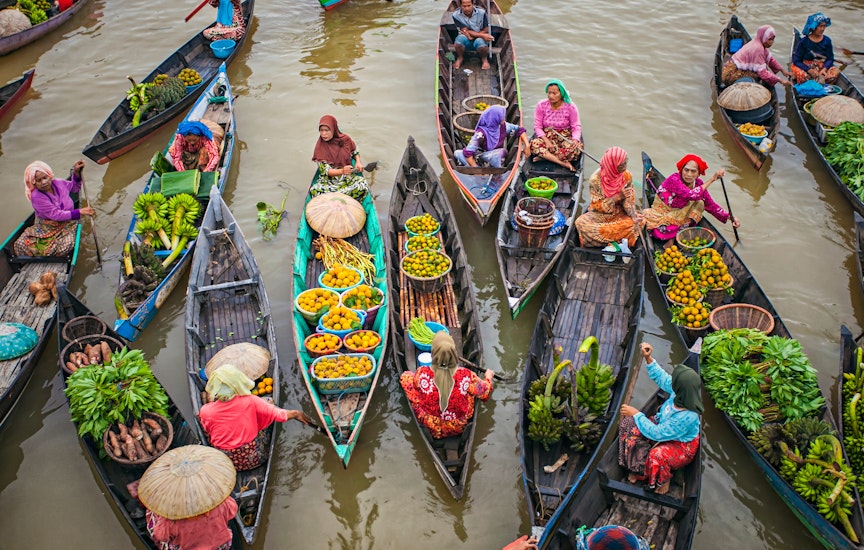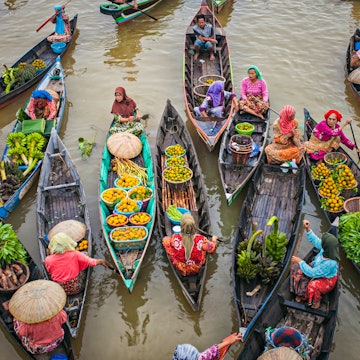

Here's what you need to know to plan the perfect trip to Raja Ampat, Indonesia's biodiversity hot spot. Paul Harding for Lonely Planet
Only a couple of decades ago, Indonesia’s Raja Ampat Islands – a stunning collection of 1500 islands, atolls and cays speckled off the tropical coast of Papua – were so remote and little-known that only pricey liveaboard dive boats sailing from Komodo or Maluku would venture out here, joined by the odd, intrepid, scuba-diving backpacker.
There were hushed whispers about the sublime diving in the so-called Coral Triangle, where the Pacific and Indian oceans collide; some even claimed it was the best in all of Southeast Asia. Fast forward to 2025 – while Papua is still one of the most remote parts of Indonesia, these stunning islands are more accessible than ever, and not just for divers.
If you’re accustomed to cheap travel in Southeast Asia, you might want to take a deep breath – accommodation and local boat travel are still relatively expensive here. But the days of relying on liveaboard schooners and luxury dive resorts to meet your underwater dreams are over.
These days, you can stay with a Papuan family in a simple but comfortable palm-thatched homestay bungalow and still enjoy the diving for a fraction of the cost of taking a liveaboard tour. One thing you won’t find here is crowds – get in before this island wonderland really does get discovered. Learn more with our guide to the Raja Ampat Islands.
When should I go to the Raja Ampat Islands?
Raja Ampat has a warm equatorial climate year-round, but the peak season for diving and sunshine is the dry season from November to April. Heavier rains hit from June to September, and the usually smooth seas can get rough, potentially shutting down boat travel in July and August. If you just want to lounge around, snorkel and explore the islands, consider the shoulder seasons of October and March – flights to Papua from Bali or Jakarta will be cheaper at this time too.
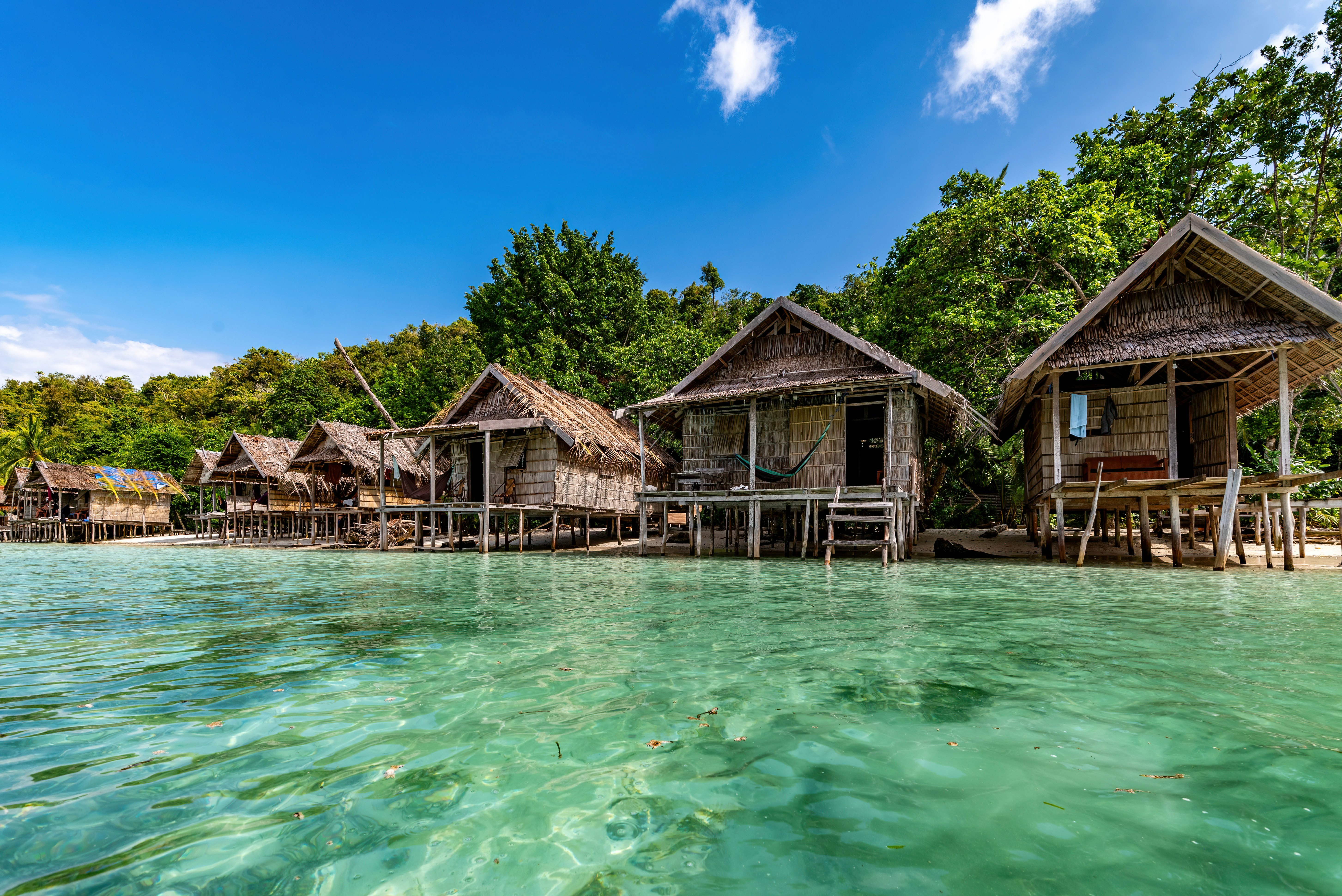
How much time should I spend at Raja Ampat Islands?
If you’re booked on a liveaboard boat or staying at a dive resort, tour packages typically last from five to 14 days, with diving most days. If you’re traveling independently, you should pencil in a stay of at least a week – it’s an effort to get here, so relax and take your time!
Allow an overnight shopping stop in Sorong, the capital of Southwest Papua, and one night in Waisai, the largest town in the Raja Ampat Islands, especially if you’re interested in spotting the islands' famous birds of paradise. The rest of your time will be spent island-hopping, diving, snorkeling, fishing or just lounging on your overwater hammock.
Getting to and around the Raja Ampat Islands
Getting to Raja Ampat usually starts with a trip to Sorong, where you can stock up on luxuries that you won’t find on the islands. Most visitors arrive by air from Jakarta or Bali, but ferries run by Pelni also sail in from neighboring islands such as Maluku and Sulawesi.
Twice daily ferries depart at 9am and 2pm from Sorong’s harbor to the port of Waisai (two hours) on Raja Ampat’s main island of Waigeo, from where chartered speedboats are available at the harbor for more direct trips to your accommodation or island of choice. These can be more expensive than your flight to Papua, so try to find fellow travelers to share costs with – the Stay Raja Ampat Facebook page is a good place to start looking.
All independent visitors must pay the Raja Ampat Marine Park fee of 700,000Rp (US$43) and the Raja Ampat Visitor Entry Ticket charge of 300,000Rp (US$18.50) – this makes an even one million rupiah, which can be paid in cash or by credit card at Waisai harbor.
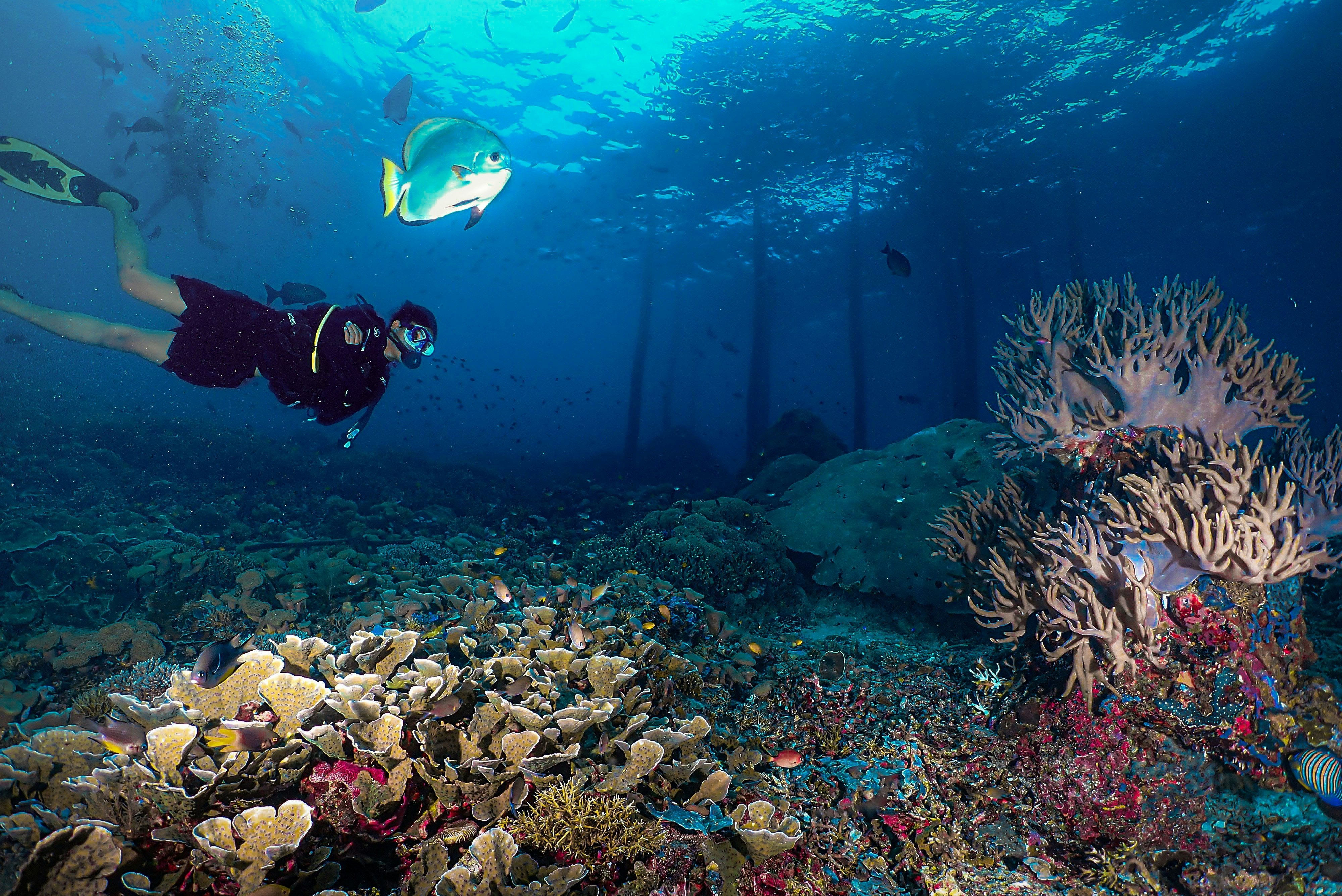
The best things to see and do in the Raja Ampat Islands
There's more to Raja Ampat than diving, but exploring the underwater world is understandably the focus for many visitors.
Enjoy wild underwater adventures
Raja Ampat's reefs are the stuff of legend, protected as a marine reserve and spectacularly stocked with brilliantly colored corals, vertical walls and underwater ridges. Giant manta rays, green turtles and schools of barracuda casually glide by, and you might encounter wobbegongs, epaulette sharks, pygmy seahorses, and pods of whales or dolphins in open water.
Many divers consider Raja Ampat to be the pinnacle of underwater exploration in Indonesia, but currents are strong here and most of the 20-plus dive sites are considerably deeper than 20m (66ft), or drift dives that require an advanced open water certification as a minimum. Celebrated sites include Mike’s Point, Cape Kri, Manta Ridge and Blue Magic. Dive resorts and liveaboards usually require dive insurance and a medical certificate, along with proof of your dive certification.
If you’re not an experienced diver, don’t be put off. There’s rewarding snorkeling straight off the beach on most islands, and the shallow waters by the piers or jetties at Kri, Aborek and Mansuar are safe for novice divers and thronged with sea life – PADI Open Water courses often start from here.
Some homestays and outfits such as Soul Scuba Divers on Kri offer budget diving from 750,000Rp (US$46) per dive. Dives can be booked a day or so in advance, or your homestay can take you to someone who can make arrangements. Always check the accreditation of operators and divemasters and the standard of equipment before committing to a dive.

Explore Raja Ampat's islands
Raja Ampat means "Four Kings" in the Bahasa Indonesia language, referring to the large islands of Waigeo, Batanta, Misool and Salawati. Budget travelers are most likely to visit Waigeo’s capital, Waisai, the only town of any size in Raja Ampat and the destination for the ferry from Sorong.
Less than an hour southwest of Waisai by speedboat are a string of islands that are perfectly placed for the region's best dive sites, with a growing number of homestays run by Papuan families that are easy places to fall in love with.
Since a major cost in Raja Ampat is getting around by boat, most travelers pick one island as a base, exploring from there. The tiny island that pioneered resort diving and kick-started the homestay trend is Kri, where the appealing Kri Eco Resort opened in 1990. You should have no trouble joining up with other Kri-bound backpackers at Waisai harbor to share boat costs.
Neighboring Mansuar is a larger island with villages, basic shops and a medical clinic. Another easily accessible island that is tightly packed with homestays but still retains a local feel is Aborek. The Fam Islands offer a remote castaway experience and easy access to the island lookout at Piaynemo. For something closer to the ferry port, forested Gam is the nearest island to Waigeo, with dozens of well-spaced beachfront homestays.
Climb Piaynemo for stunning views
The classic postcard image of Raja Ampat is the view over a bay of mushroom-shaped, forested islands poking out of impossibly beautiful waters in shades of turquoise and teal green. Find the real-life version by hiking up to the lookouts at remote Wayag or smaller but much more accessible Piaynemo, a popular day-trip by boat from Kri or Waigeo.
Expect to pay up to 4,000,000Rp (US$246) for a Piaynemo trip. On arrival, a boardwalk and stairs lead from the jetty to the summit of the hill for sensational views over the bay and out to the Fam Islands. Boat trips here often include snorkeling at nearby Rufus Island and a stop at tiny Arborek Island, where the village offers a chance to see traditional Papuan dancing and local handicrafts.
Planning tip: If you're thinking of taking a day tour to Piaynemo, ask at your homestay and neighboring homestays for other travelers who are willing to split the cost – boat captains usually charge by the boat, not per person.
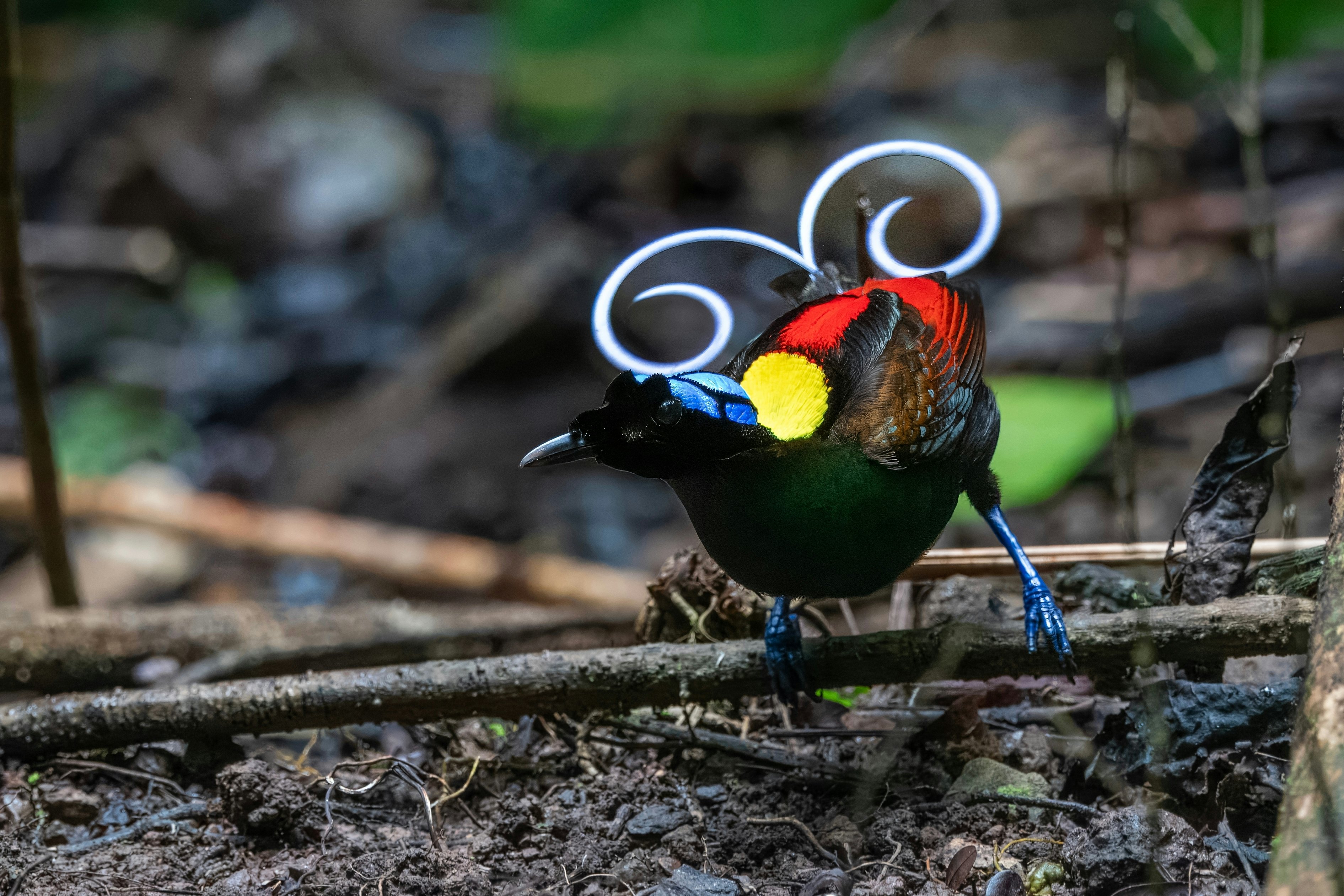
Spot dancing birds of paradise
Waigeo Island is the easiest place to see the courtship display of the islands' exotic – and aptly named – birds of paradise. The Wilson’s bird of paradise and red bird of paradise are regular visitors to nesting sites on the island. Set your alarm for 4:30am for the trip from Waisai for a sunrise display of avian dancing – local guides charge from 150,000Rp (US$9.25) for a tour. Most local guesthouses can arrange trips, but Husna at Sandy Guesthouse is a solid bet.
Stay with a Papuan family
While serious divers look to upmarket dive resorts and liveaboard diving tours – more than 60 boats operate in these waters, mostly sailing from Sorong – budget travelers should head for the family-run homestays on islands such as Kri, Arborek, Gam, Waigeo or the more remote Batanta or Fam Islands.
Don’t expect luxury (or even a family home) – staying here is all about the beachfront location. Most homestays are simple bamboo, timber and palm-thatch bungalows with a mattress on the floor and a mosquito net. Proper overwater stilt bungalows won’t even have an attached mandi (bathroom), but bungalows built on the beach typically have private bathrooms and seafront balconies.
The experience is a fascinating introduction to island life. Children play in the shallows, curious dogs come out to investigate newcomers, and communal meal times bring worldly guests, weary divers and host families together over a steaming plate of rice, vegetables and fresh caught fish.
Don’t expect much in the way of nightlife, though most homestays should be able to rustle up a Kingfisher beer or some local palm wine. The term "budget" is relative here – homestay prices start from around 500,000Rp (US$31) per person per night, including three meals (solo travelers pay the same, not double). In season, prices rise to around 800,000Rp (US$49).
Stay Raja Ampat represents Papuan-owned homestays, with an excellent website and an information center in Waisai, though it's not a booking service. Check the website for reviews, pricing and tips for planning a trip.
Raja Ampat travel tips
You'll have a smoother trip if you follow these essential tips.
Bring plenty of cash – there’s only one ATM in Waisai and no locals accept credit cards.
Electricity at homestays is provided by diesel generators, but only between dusk and around 11pm - charge your devices then!
Stone fish, stingrays and sea urchins lurk on the sandy seabed, so wear reef shoes or fins when snorkeling or swimming.
The Telkomsel 4G cellphone network works pretty well on the main islands, but wi-fi is limited to the upmarket dive resorts.
Budget is a relative concept in Raja Ampat – you can stay in a four-star hotel in Sorong for the same price as a homestay on the islands.





